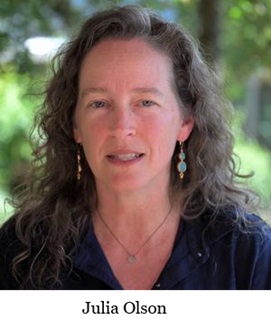 Post an Event
Post an Event
| Benton County Republicans’ Private Fundraising Event, “Bent-on Boots and Bling” with Trey Taylor |
| Friday, September 5, 2025 at 5:00 pm |
| Featuring Trey Taylor
Music Private Event
Friday, September 5, 2025 5:00-5:30 pm VIP Reception
5:30-8:00 pm Heavy Appetizers,
Auction, Concert
Red: $750 VIP Reception
Front Row Table Sponsor
White: $500 Table Sponsor
Blue: $50 per person
Limited Seating. Get Yours Now!!!
Support Local
Dress up: Bling, Cowboy, Patriotic Benton County Republican
FUNDRAISER
www.BentonGOP.org
Get your tickets today at:
https://www.bentongop.org/event-details/benton-county-republicans-fundraiser/form
About Trey:
Trey is the youngest African American Man in Country Music History. The Denver Post wrote
"It's impossible to miss his enthusiasm. With a fondness for cowboy boots, gaudy colors and dazzling jewelry, Trey Taylor could stand toe to toe with any of the Pop, Country or even Rap
contemporaries of his generation.“ |
| Trysting Tree Golf Club, 34028 NE Electric Rd., Corvallis |
How much will marine reserves be affected by increased ocean noise?
Oregon legislature passed
HB 4132 (2024), which is designed to protect marine life along Oregon’s coast. This bill focuses on Oregon’s
five marine reserves, which are coastal waters dedicated to scientific research and conservation. HB 4132 requires the state to outline ways to continue protecting these coastal waters from developments and other threats to marine life. It provides the Oregon Department of Fish and Wildlife with funding to do this work.
For relatively low cost ($1 million/biennium), HB 4132 provides support to build a state-of-the-art Marine Reserves Program. It will allow more robust monitoring, adaptive management, and ocean resiliency in the face of a changing climate to support biodiversity and our economically important fisheries.
A "marine reserve" defines an area within coastal waters dedicated to scientific research and conservation, where ocean development and removal of marine life is prohibited. A "marine protected area" refers to coastal waters directly next to a marine reserve, which have site-specific rules that allow some fishing activities while prohibiting development. Oregon currently has five marine reserves that have been officially designated for ocean areas along the coast. These marine reserves are managed by the Oregon Department of Fish and Wildlife, which handles planning and oversight of scientific research as well as monitoring within the reserves.
The five established marine reserves are:
- Cape Falcon - Established in 2016, the Cape Falcon Marine Reserve is the northernmost reserve, just off of Oswald West State Park, near Manzanita. This site includes a marine reserve plus two Marine Protected Areas.
- Cascade Head - The Cascade Head Marine Reserve is located off the central Oregon coast, stretching between the Cascade Head headland and Lincoln City. The site includes a marine reserve surrounded by three Marine Protected Areas and was established in 2014.
- Cape Perpetua - Oregon’s largest marine reserve is the Cape Perpetua Marine Reserve, established in 2014 between Yachats and Florence on the central Oregon coast. This area comprises a marine reserve, two Marine Protected Areas, and a Seabird Protection Area.
- Otter Rock - The Otter Rock Marine Reserve is on the central Oregon coast, near the unincorporated town of Otter Rock. As Oregon’s smallest marine reserve, it spans 1.2 square miles and was established in 2012.
- Redfish Rocks - The Redfish Rocks Marine Reserve, established in 2012, is positioned between Rocky Point and Coal Point, just south of Port Orford. This area includes a Marine Protected Area to the west.
It isn't without opponents claiming the plan “will shut down poor people’s access to natural sustainable fishing. This has nothing to do with helping the ecology, it’s simply a communistic shut down of access to food.” They further object to when “Jimmy Carter changed the laws so the Japanese and Chinese can come into USA waters and take as many Salmon as they want and government continues to tax us to death for Salmon Enhancement.”
The open question is the effect of the noise from ocean windmill farms on ecosystems and marine life. From the book,
Ocean Noise and Marine Mammals, “When underwater objects vibrate, they create sound-pressure waves that can disturb the natural behavior and habitats of marine animals.”
Some of the effects on marine life includes:
- Loud sound waves can cause internal injuries in fish and, in the long term, physical malformations and increased infertility.
- Shrimp and mussels are also affected, with growth disturbances, reduced fertility, and associated low reproduction rates.
- Animals may flee their habitats, stopping their hunt for food and using up their reserves, which can have cascading effects on entire populations.
A D V E R T I S E M E N T

A D V E R T I S E M E N T
The speed of sound in water is faster than air and travels significantly farther, allowing them to travel thousands of miles at 1,500 meters per second. They may vary with water temperature, salinity, and the source of the sound frequency.
The dominant physical mechanisms of naturally occurring sound in the ocean occur at or near the ocean surface. Most are associated with wind fields acting on the surface and the resulting surface wave activity. Even offshore wind farms have a big impact on underwater pollution. From their construction to their deployment, offshore wind farms, with their turbines and metallic foundations, generate noise and vibrations below the sea surface (called “anthropogenic noise” because it is unnatural and human-made) that disturb marine life and flora, especially for the underwater mammals that rely on sound (like echolocation or vocalization) to survive in the ocean. The impacts of underwater noise pollution on marine life can vary from species to species and long-term effects are yet to be confirmed.
Ocean windmill farms underwater power cables carry the renewable energy from the offshore wind farms to the mainland grid emit electromagnetic fields (EMFs.) These artificial magnetic fields can interfere with, and even mask, the natural EMFs present in the ocean.
Established daily ocean activity has more than doubled in 25 years increasing 0.55 dB per year. This increase was attributed to commercial shipping, namely a doubling of the number of ships. Noise measurements was also made on a receiver on the continental slope of Point Sur, California, that caused and increased noise from 100 to 400 Hz that they have no satisfactory explanation for.
Ocean noise is increasing and potentially five-times due to climate change. Climate change will create areas with amplified noise levels from human-generated noise, such as windmills. These hotspots could impact essential activities of marine life.
--Donna Bleiler| Post Date: 2024-07-26 08:33:00 | Last Update: 2024-07-27 18:18:59 |
"Market-based approaches are the only solution to these service issues."
Many West Coast homeowners are receiving notice that their homeowner’s insurance is being canceled or increased.
"This is devastating," says Senator Daniel Bonham (R-The Dalles). "The average American can barely afford their current home payments let alone increases averaging hundreds of dollars a month.
"Like any industry, the home insurance industry is at a crossroads. With increasing fires due to poor land management for the past decade, the government jumping to overregulate and the lack of market reserves - insurance companies are either pulling out of states or charging impossible premiums. No one is winning in this current market.
"Attempts to create a government-run insurance plan have been met with homeowner complaints about poor service, rising costs and threats of getting kicked off the plan. Government-run programs quickly learn, what private companies already know - providing services efficiently is a tall order with a lot of nuances.
"As the West Coast moves toward more thoughtful land management practices, states need to put in the work to attract types of companies to the market, not seek to overregulate and create government-run alternatives.
"Market-based approaches are the only solution to these service issues. States need to roll up their sleeves and seek to find regional approaches to insurance coverage. Businesses need to be incentivized to learn the nuances of each area and to come up with new technological advances to make homes safer. Further, the nation needs to streamline insurance regulations to reduce cost pass-throughs to consumers.
"Private industry in partnership with government entities will always provide the best service for a consumer. Home insurance is no different. Learn more about free market insurance concepts
here."
Three years after the 2020 Labor Day wildfires, many homeowners were still blocked by regulations to rebuild and their homeowners insurance was running out. If the state worked for the people, as it was designed, the market would work more effectively.
--Donna Bleiler| Post Date: 2024-07-23 19:44:31 | Last Update: 2024-07-23 21:06:19 |
Boosts funding by estimated $515 million over current service level to address K-12 education funding
Oregon Governor Tina Kotek unveiled a proposal to boost the current service level (CSL) for the State School Fund by an estimated $515 million above the original CSL calculation for the 2025-27 biennium. Representatives from the Governor’s Office, Oregon Department of Education (ODE), and the Chief Financial Office (CFO) presented this information to the legislative
Joint Task Force On Statewide Educator Salary Schedules last Wednesday. This estimate will be updated prior to the 2025 legislative session.
The State School Fund (SSF) is the primary source of state funding for K-12 public education. Current service level is the amount of money needed in the upcoming biennium to continue existing authorized programs.
“Across the country, school districts are facing budget shortages caused by the expiration of federal pandemic relief dollars, declining enrollment, increasing costs due to inflation, and many other factors,” Governor Kotek said. “In response to the way these issues are impacting Oregon students, educators and administrators, I committed to reviewing and updating the methods of how the State funds public schools.
“We are working to be a stronger, more accurate and predictable funder of K-12 public education across Oregon. This effort is part of my priority to ensure we are moving the needle on improving education outcomes for our students, from improving early literacy rates to preventing learning loss to increasing graduation rates. And, ultimately it’s about more than just resources – it’s about the specific outcomes.”
A D V E R T I S E M E N T

A D V E R T I S E M E N T
The Governor is directing agencies to take three steps in order to increase funding:
- Budget Distribution - 49/51 Split: For the last decade, the State of Oregon has budgeted SSF distributions to school districts on a 50/50 split over a two-year period (meaning districts received 50% of funds in year 1 and 50% of funds in year 2). This proposal changes the distribution to a 49/51 split.
This will increase the CSL calculation for the next biennium because CSL is built off the funding available in the second year, which increases when districts receive 51% in the second year, compared to 50% previously.
The change will also support school districts in planning to cover rising costs that occur in the second year of the biennium after the SSF has already been set.
Preliminary Estimate: $217 million increase in the CSL for the 2025-27 biennium.
- Compensation Costs: The State’s method to account for compensation costs of teachers, administrators, and classified staff is based on a model that looks back at 20 years of historical data. This model has proven to be very accurate (more than 98%) in calculating actual compensation costs, based on the information school districts submit to ODE. That also means the State has historically been within 2 percentage points of being completely accurate.
The Governor’s direction to close the gap between projected compensation costs and actual compensation costs over the last 10 years – instead of 20 years – will increase the SSF CSL. The 10-year period gives us more accurate and more recent data than 20 years. This one-time increase will reflect an even more precise compensation projection and leads to the largest funding increase in the proposal. It’s also important to note that this change will roll forward into future two-year budget cycles.
Preliminary Estimate: $240 million increase in the CSL for the 2025-27 biennium.
- Local Property Tax Revenue: SSF funding to districts represent a combination of local revenue (34%) and state revenue (66%). The State’s historical practice doesn’t include fluctuations in local property tax revenue in the second year of the biennium. This limits the State’s ability to accurately account for the level of resources available for our schools.
Going forward, the Governor has directed State agencies to account for annual information for projected local revenue, with the goal of increasing accuracy and precision.
Preliminary Estimate: $55 million increase in the CSL for the 2025-27 biennium.
--Donna Bleiler| Post Date: 2024-07-21 19:16:15 | Last Update: 2024-07-21 21:18:30 |
“I am honored to help advance Governor Kotek’s environmental agenda and have a particular interest in the climate protection program”
At their most recent meeting, the Oregon Environmental Quality Commission designated Matt Donegan as the commission chair. The commission is the governing body for the Oregon Department of Environmental Quality, responsible for reviewing and adopting agency policies and rules.
Donegan said, "I am honored to be designated chair of the commission to provide leadership service to DEQ and to Oregon.” “Although I am new to the commission and have a lot to learn from DEQ staff and from my fellow and former commissioners, I bring experience having chaired other state boards and commissions and I believe very strongly in the mission of the agency,” he said.
“I am honored to help advance Governor Kotek’s environmental agenda and have a particular interest in the climate protection program. The climate crisis has reached a tipping point, and I am eager to see Oregon protect its citizens and assert leadership on this critical issue,” said Donegan.
Donegan is a leader in building public-private partnerships to address the wildfire crisis caused by climate change. In 2019, he was appointed to chair Oregon’s Wildfire Response Council to evaluate the state’s system of response to large fires. It was a two-year effort during which he convened federal, state, and local government officials, scientists and environmental groups, and business and industry groups to develop recommendations for the future of Oregon’s wildfire response infrastructure. The Council’s recommendations served as the basis for recent wildfire legislation.
"I am pleased with the commission’s vote to designate Matt Donegan as chair of the EQC and grateful for his willingness to serve Oregon in this critical leadership role," said Leah Feldon, DEQ Director. "He brings extensive policy and leadership experience working within various environmental spheres, which will be a valuable resource to the agency as we continue to develop innovative, equitable and resilient environmental policies and regulations,” she said.
Donegan currently serves on the Lewis and Clark College Sustainability Board and as a fellow for the Oregon Business Council. His prior state service includes chairing both the Governor’s Council on Wildfire Response and the Oregon State Board of Higher Education. He was also a founding member of the Oregon Global Warming Commission, the Oregon Innovation Council and the Oregon Education Investment Board, and has served on various other private and non-profit boards and commissions.
[[AD_SLUGG9]]
Oregon’s Senate approved Governor Kotek’s nominations of Donegan and Karen Moynahan to the commission on May 31, 2024. Their terms began July 1, 2024.
--Staff Reports| Post Date: 2024-07-20 13:45:52 | Last Update: 2024-07-20 13:57:50 |
As of July 2024, five boards are inoperable due to volunteer board member vacancies across 14 counties
As global tensions rise and military recruitment faces challenges, the Oregon National Guard is playing a vital role in supporting the Selective Service System, ensuring the state remains prepared for potential national emergencies.
The Selective Service System, an independent agency within the executive branch, is responsible for rapidly providing personnel to the military in a fair and equitable manner if the President and Congress authorize conscription. While the United States has maintained an all-volunteer force for decades, the system remains a crucial component of national defense readiness.
"The Selective Service is a vital pillar in our national defense posture," said Michael Kalberg, Oregon's State Director for the Selective Service System. "Even though it may be overlooked by some, it's an important component of our government."
In Oregon, the Selective Service State Headquarters is located at the Salem Armory on 17th St. The state's mission includes maintaining staffing for local draft boards, preparing to activate a fully operational state headquarters if needed, and supporting the ongoing registration of 18-year-old males.
Lt. Col. Robert Earhart, the Selective Service Reserve Service Member for Oregon, explained the system's role: "Most people are familiar with the draft during World War Two through Vietnam. It's been a volunteer force for the past several decades, so the draft has not been going on. But every state needs to have an apparatus in place in case the President and Congress reinitiate conscription."
The Oregon National Guard provides critical support to the Selective Service mission. This partnership includes sharing facilities, logistical support, and personnel. In addition to occupying space at the Salem Armory, National Guard Armory facilities and administrative equipment would be made available for temporary operations in the event of activation.
"We've had a lot of success in Oregon over the last 50 years, and this office has been functional," Earhart said. "A lot of great people have come through, and a lot of great volunteers helping us along the way."
However, the system faces challenges, particularly in rural areas. Oregon is divided into 18 local boards, with nine single-county boards and nine multi-county boards. As of July 2024, five boards are inoperable due to volunteer board member vacancies across 14 counties.
"We have vacancies quite a few vacancies around the state," Earhart noted. To reach board capacity, "I could probably fill another 30 slots."
These local boards play a crucial role in the Selective Service process. In the event of a draft, board members would review and decide on draftee claims for exemptions, postponements, or deferments from military service.
"It's a big responsibility because you hold someone's future in your hands," Earhart explained. "It's a matter of trust, logic, and an understanding of the story being told to you."
The time commitment for board members is minimal during peacetime — approximately five hours in the first year and two hours annually thereafter. However, their role becomes expanded and critical if a draft is reinstated.
Kalberg emphasized the unique challenges Oregon faces in maintaining the Selective Service System. "Oregon is not a high-visibility military state. We don't have a lot of military footprint [in Oregon]," he said. For that reason, probably in particular, Oregonians have never had a history of high registration compliance when young men turn 18."
Despite these challenges, recent efforts to bolster the system have shown promise. Earhart has been conducting outreach with agency partners, the governor's office, county commissioners, and service organizations like the VFW and American Legion, which has resulted in several new volunteers in the pipeline.
A D V E R T I S E M E N T

A D V E R T I S E M E N T
The Selective Service is also adapting to potential changes on the national level. Congress is considering bills that could expand registration requirements, such as the automatic registration of 18-year-old males and including women in the draft. If passed, these changes would significantly increase the workload for local boards.
"If mandated, it'll be an interesting reaction," Kalberg said. "We're not worried about it, but we do need to get the numbers on the paper, get [board members] trained, and get them ready."
As geopolitical pressures mount and military recruiting struggles to meet its quotas, the importance of the Selective Service System has been identified as a backstop for national defense. Dr. Kathleen Hicks, Deputy Secretary of Defense, recently stated, "I don't want people to think the all-volunteer force is sort of alone when the United States must make major decisions. They do not stand alone."
The Oregon National Guard and Selective Service System are actively seeking volunteers to serve on local boards, particularly in rural areas. Interested citizens can apply
online to "Get Involved." Eligible individuals must be U.S. citizens, at least 18 years old, and willing to undergo training and dedicate time to this crucial role in national preparedness.
"We're looking for dedicated individuals who want to serve their community and country in this important capacity," Earhart said. "It's a unique opportunity to play a vital role in our national defense structure."
For more information on volunteering or the Selective Service System in Oregon, you can contact Lt. Col. Robert Earhart, SSS Reserve Service Member, at 503-779-9473 or rearhart@sss.gov.
--Donna Bleiler| Post Date: 2024-07-18 23:15:15 | Last Update: 2024-07-18 23:34:42 |
“Political violence has no place in American politics”
Oregon House Republican Leader Jeff Helfrich (R-Hood River) and Senate Republican Leader Daniel Bonham (R-The Dalles) have called on Gov. Tina Kotek to remove Cass McLeod-Skinner from her position as director for the Oregon Board of Chiropractic Examiners over her amplification of comments supporting the assassination attempt against former President Donald Trump.
McLeod-Skinner reposted a social media post that expressed disappointment that the shooter had not succeeded in murdering the former president and current Republican nominee for President of the United States.
In a
letter to Governor Kotek, Helfrich and Bonham said the following:

“Political violence has no place in American politics. Certainly, those who believe that it does should not be in positions of authority in Oregon state government. With her amplification of pro-assassination messages, Cass McLeod-Skinner has demonstrated that she is unfit for the position she holds with the Oregon Board of Chiropractic Examiners. Gov. Kotek rightly denounced violence in the aftermath of the shooting, and now she has an opportunity to put her words into action by removing McLeod-Skinner from her position to signal that such dangerous rhetoric is unacceptable.”
According to the Oregon Board of Chiropractic Examiners
website, Cass McLeod-Skinner has been the Executive Director for the Oregon Board of Chiropractic Examiners since 2014. Cass came to the OBCE with a background in public health and public service, having held positions as General Counsel and Health Equity Officer for Trillium Community Health Plan and Chair of the Board of Commissioners for Oregon’s Liquor Control Commission. Her spouse is Jamie McLeod-Skinner who lost to Janelle Bynum in a race for the current Democratic nomination for Oregon's 5th Congressional District.
--Staff Reports| Post Date: 2024-07-17 15:31:05 | Last Update: 2024-07-17 16:28:41 |
US Fish and Wildlife Service Releases Plan to Protect At-Risk Spotted Owls
The U.S. Fish and Wildlife Service is announcing its final environmental impact statement analyzing proposed
barred owl management alternatives to protect northern and California spotted owls in Washington, Oregon and California from invasive barred owls. The Service’s preferred alternative is the implementation of a proposed Barred Owl Management Strategy, which would result in the annual removal of less than one-half of 1% of the current North American barred owl population.
According to USFW, Northern spotted owl populations are rapidly declining due to competition with invasive barred owls and habitat loss. California spotted owls, which are proposed for
ESA listing, face a similar risk as barred owl populations continue to move south into their range.
“Barred owl management is not about one owl versus another,” said Service Oregon Office state supervisor Kessina Lee. “Without actively managing barred owls, northern spotted owls will likely go extinct in all or the majority of their range, despite decades of collaborative conservation efforts.”
If the proposed strategy is adopted and fully implemented, lethal removal of barred owls by trained professionals would occur in less than half of the areas where spotted and invasive barred owls co-exist within the northern spotted owl’s range; and would limit their invasion into the California spotted owl’s range. Public hunting of barred owls is not allowed under the proposed strategy and lead ammunition will not be used for any lethal removal actions.
A D V E R T I S E M E N T

A D V E R T I S E M E N T
“Barred owl removal, like all invasive species management, is not something the Service takes lightly,” said Lee. “The Service has a legal responsibility to do all it can to prevent the extinction of the federally listed northern spotted owl and support its recovery, while also addressing significant threats to California spotted owls.”
Barred owls are native to eastern North America but started moving west of the Mississippi River at the beginning of the 20th century. This expansion was likely due to human-induced changes in the Great Plains and northern boreal forest. As a result, barred owls now surpass northern spotted owls in numbers across most of California, Oregon, and Washington.
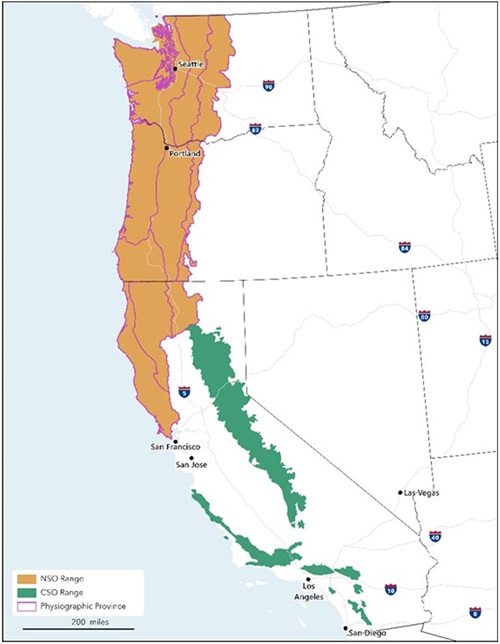
If the proposed strategy is adopted, the Service would receive a permit under the Migratory Bird Treaty Act. The Service could then designate interested Tribes, federal and state agencies, companies, or specific landowners to implement barred owl management on their lands if actions are consistent with the strategy, conditions of the permit, and state laws and policies. Those who implement the strategy will be accountable for annual monitoring and reporting.
The final EIS and proposed strategy reflect the input received throughout the scoping and public comment process, as well as feedback from cooperating agencies and Tribes. The Service expects to announce a final record of decision on the proposed strategy at least 30 days after the formal publication of the final EIS in the Federal Register.
More information is available on the Service’s
barred owl management website, including the draft and
final EIS,
proposed strategy and frequently asked questions. The final EIS will be available in the coming days in the Federal Register and at https://www.regulations.gov at Docket No. FWS-R1-ES-2022-0074.
--Staff Reports| Post Date: 2024-07-16 09:59:55 | Last Update: 2024-07-16 20:32:53 |
“Over-the-top partisan rhetoric about fake "threats to democracy" have contributed to this”
In response to the attempted assassination of President Trump today in Pennsylvania, House Republican Leader Jeff Helfrich (R-Hood River) offered the following statement.
“Our prayers are with President Trump. Democrats not only need to denounce this despicable act of violence, they must also consider how their over-the-top partisan rhetoric about fake "threats to democracy" have contributed to this,” said Helfrich. “We settle disputes in this country with our votes, not violence.”
Senate Republican Leader Daniel Bonham (R-The Dalles) also issued a statement.
“Today, we should all be reminded that violence has absolutely no place in our political discourse. It threatens our country and the principles upon which it was built. This violent attack is not just an assault on one individual but on our collective values. This moment transcends political affiliations and ideologies,” said Leader Bonham.
Bonham called for bipartisan unity in the face of such threats, urging all Oregonians to come together in condemnation of this act. “Let us honor our commitment to preserving the integrity of our republic and ensure it remains a beacon of freedom and justice for all. As Americans, we must stand united against any form of violence or intimidation.”
“We extend our prayers to President Trump and his loved ones during this difficult time. We also offer our heartfelt condolences and prayers to the families of those who lost their lives in this heinous attack.”
--Staff Reports| Post Date: 2024-07-13 15:59:16 | Last Update: 2024-07-13 17:36:04 |
Steiner is Democrat’s pick for Oregon Treasurer
Effective July 15, Oregon Senator Elizabeth Steiner is ending her time as one of the Ways and Means Co-Chairs to focus on campaigning for Oregon State Treasurer. She has served as co-chair since 2019. Steiner is using her time on the committee as reason to vote for her for Oregon's Treasurer.
The Joint Ways and Means Committee is responsible to appropriate and passing all budget related items in the Oregon Legislature. Steiner claims to be "Oregon's chief budget writer" as the Co-Chair of the Ways and Means Committee. She says her job has been to decide the funding for each of the components for agencies and any other state expenditures with the constitutional requirement to have a balanced budget. This includes passing agency budgets, policy bills that have a money component, and capital construction projects that utilize bonds.
Dr. Elizabeth Steiner identifies her candidacy for State Treasurer, “as a physician, a mom, and one of Oregon’s chief budget writers, I’ve seen firsthand how investing in preventive care, saving for education, and balancing a budget can make all the difference for hard-working families.”
Steiner is a Democrat from Northwest Portland who was first appointed to the Oregon Senate in late 2011. If elected Oregon State Treasurer, she would be the first woman in history to hold the office.
KGW interviewed Steiner about investments and the agenda to block fossil fuel investments. "This is one of those 'truth lies in between' questions," Steiner offered. "Which is to say, I strongly support making Oregon and the whole world cleaner and greener and cooler and reversing the impact of climate change. That means helping companies that are big polluters move toward cleaner technology. One of the ways you do that is to use your power as a shareholder — and the treasury is a big shareholder in a lot of these companies — to push them to make these green investments. And there are plenty of examples nationwide of investors pushing brown companies to move towards green technologies."
When asked if that's more effective than disinvesting, Steiner responded, "Yeah. Here's the problem. If you invest solely in green companies, they don't have a lot of room to cut their emissions. But if you invest in brown companies and push them to move toward clean technology, even a relatively small reduction in their emissions makes a big difference in the world. And so I think we need to think about that. It's also hard if — as treasury does for the pension fund — you invest in index funds, for example, and you don't get to pick every stock that's in there. You don't get to say, 'Well, I'll only invest in this fund if you pull out all the fossil fuel investments.'"
Her reference to “brown” companies refers to high-emitting companies.
Research by Yale concludes that the sustainable investing practice of divesting high-emitting companies (referred to as “brown” firms) in favor of low-emitting companies (referred to as “green” firms) is counterproductive to reducing greenhouse gas emissions.
A D V E R T I S E M E N T

A D V E R T I S E M E N T
Despite Steiner's campaign philosophy, she was a sponsor of HB 4083, which requires the State Treasurer to stop investing moneys in companies that deal in thermal coal. It directs the Oregon Investment Council and the State Treasurer to make efforts to eliminate certain investments in thermal coal companies, except if it is transitioning to clean energy. The council may adopt rules to reflect guidelines of the United Nations Intergovernmental Panel on Climate Change regarding necessary decreases in greenhouse gas emissions. This allows the State Treasurer to politicize investments and go outside the legislative authority to establish rules, which now may be in violation of the Supreme Court Chevron decision.
Steiner says she wants to build a stronger Oregon, which she views as investing in the health of our families, kids, and communities. “Over 30 years of experience as a doctor has given me a deep understanding of how agencies can better work together in our state government to improve the health of Oregonians, offer students a great education, and ensure our communities, families, and economy can thrive.”
Steiner's goals for budgeting is often confused with understanding investment options and assessing risks. As Treasurer, there is a fiduciary responsibility to invest in the best interest of Oregonians for sustainable growth, and not political goals. The voter will decide between Steiner and Senator Brian Boquist, the Republican candidate.
--Donna Bleiler| Post Date: 2024-07-12 07:13:00 | Last Update: 2024-07-10 14:01:02 |
HR 8281 would prevent illegal aliens from voting in US elections
Republican candidate Monique DeSpain reacted to Val Hoyle’s
vote opposing
HR 8281, which would require individuals to provide documentary proof of U.S. citizenship in order to register to vote in federal elections, effectively prohibiting non-citizens, particularly millions of illegal migrants, from being able to vote in federal elections this November.
“Yesterday, Val Hoyle voted against the bipartisan, commonsense HR 8281
Safeguard American Voter Eligibility (SAVE) Act to require proof of citizenship to vote in federal elections,” stated DeSpain. “Most Americans assume this isn’t even possible. However, with more than ten million illegal migrants that Val says we need moving across our borders and flooding into states lacking adequate safeguards against non-citizens registering to vote, this bill would eliminate this possibility and ensure voters can have faith in our elections to which they are entitled.”
Earlier this year, Val Hoyle went to El Paso, TX, and
praised open borders while lecturing her constituents who asked her, “Why don’t you just shut down the border?” explaining that
“We need to have movement through the border and how much we need the workforce.” Seven weeks later, Texas National Guard Troops at an El Paso, TX checkpoint were overrun and assaulted by foreign military-aged males forcing their way into our country. In another bid to manipulate and distort our election system, Hoyle a href='https://clerk.house.gov/evs/2024/roll193.xml'>voted in early May against
HR 7109, the Equal Representation Act, which would have identified the massive influx of millions and millions of illegal migrants entering the U.S. during the Biden Administration while conducting the next U.S. Census and would have prohibited including illegal migrants to distort the next congressional district reapportionment by benefiting sanctuary cities and states. A few weeks ago, the Democratic Congressional Campaign Committee moved Val Hoyle to its “frontline” list of vulnerable incumbents.
A D V E R T I S E M E N T

A D V E R T I S E M E N T
“As if Val’s numerous shocking votes in favor of open borders that are enabling unlimited illegal immigration, human smuggling, fentanyl trafficking, and terrorist infiltration weren’t enough, today’s vote has exposed her plan to flood ballot boxes with illegal votes to reelect vulnerable incumbents like herself,” said DeSpain. “Now that her party bosses have put her on the list of incumbents most in jeopardy of defeat in 2024, she may actually need untraceable voting by illegal immigrants to salvage her reelection chances.”
“Once again, Congresswoman Hoyle has offered no explanation for her horrendous voting record. That’s why I have
challenged her to six debates in six counties in the 4th District so voters can hear directly from both of us what we stand for and why their current member of Congress has voted repeatedly against their interests,” said DeSpain. “Perhaps Val knows that if voters get to hear a real debate, they will vote to retire her this November and deploy me to Congress so she never gets the chance to inflict fundamental damage to our democracy.”
--Staff Reports| Post Date: 2024-07-11 20:33:53 | Last Update: 2024-07-11 20:50:44 |
Oregon continues to be used as a testing ground for radical ideas
The United States has dropped out of the top 10 in the global competitiveness rankings for the first time, according to the International Institute for Management Development (IMD) World Competitiveness Ranking. The ranking, which is based on a variety of factors including economic performance, government policies, and business environment, has been released annually since 1989.
Biden Economics has been experiencing a decline in competitiveness over the past few years, due to various factors such as:
- Social cohesion - increasing polarization and a lack of social cohesion, which can make it difficult for the country to adapt to changing circumstances.
- Adaptability and agility - slow to adapt to changes in the global economy and has been slow to respond to emerging challenges.
- Government and business efficiency - slow-moving legislative process and inefficient government bureaucracy, which can make it difficult for businesses to operate effectively.
The decline in competitiveness has significant implications for states. How the U.S. addresses the underlying issues and take steps to improve its competitiveness will affect Oregon significantly. As the U.S. declines in competitiveness, it leads to loss of state’s influence in global markets with a reduced ability for Oregon to sustain its international trade policies. Lack of competitiveness most likely will lead to economic stagnation that reduces the ability to create jobs and stimulate economic growth.
BRICS was started because of economic sanctions, which has resulted in a forced marriage of Russia to China, Oregon’s
largest export partner, with sales in 2021 totaling $10.6 billion, a third of all the state’s exports is with China. A decline in competitiveness will make it more difficult for businesses to compete with countries that are more competitive and have a more favorable business environment.
Economic sanctions on Russia has accelerated the demise of the dollar. Recently, the U.S. Treasury slapped an economic sanction on companies and financial institutions that do business with Russia. Poking at the bear when he has nuclear ships off the coast of Miami could be dangers. Biden put a pinch on imports of natural resources, aluminum, gas needed for manufacturing, and fertilizer needed for crops that are all imported from Russia, which directly affects Oregon's economy.
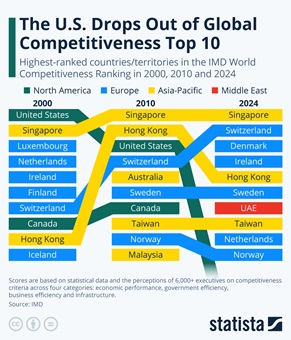
The chart is also an indication that forcing U.S. Employers to hire based on a DEI agenda rather than the quality of work is eroding in moral decay. Economist Dr. Elliott says, “Of course we aren’t going to be in the top 10 with that theology. I call it a theology because this DEI mantra is a religion to them… We are celebrating being the opposite of God in this country and that isn’t good for the economy… Biden is dedollarizing America by his policies.”
The housing market is suffering from supply and demand destroying the balance, and projected to be worst than it has ever been. Rentals are going up, caused by banks undercapitalized by 55 trillion for each Goldman Sacs and Chase with two others close behind. Hedge fund managers are selling off faster than during covid, wages are down, unemployment is up, taxes are up, interest rates and cost of borrowing is up that puts housing in a squeeze. Governor Kotek's housing goals may be a lost cause if banks aren't able to make loans, coupled with the need to import lumber due to the restrictions on harvesting by the Oregon State Land Board.
A D V E R T I S E M E N T

A D V E R T I S E M E N T
If Biden continues pushing the Democrat agenda, we can expect Putin to retaliate. This isn’t a Biden’s agenda, he is simply the current face being used. It doesn’t matter who is president, if they are a Democrat, the policies won’t change. Democrat states follow the same agenda. Oregon's leadership is in step with Democrat policies and repeatedly uses Oregon as a testing ground for some of these radicle ideas.
In 2019, Oregonians held in opposition to cap and trade when legislative bill
HB 2020 was proposed. In a last minute effort, Senator Betsy Johnson (D-Scappoose) proposed sweeping amendments as the most vocal cap-and-trade skeptic. Johnson was removed as co-chair of the Ways and Means Committee in a power play to vote the bill out of committee. After passing the House, the Senate walked out to prevent a vote. The bill died, but not cap-and-trade. Governor Brown circumvented the legislative process with
Executive Order 20-04, which was directed at state agencies but contained much broader provisions sharply curbing greenhouse gas emissions that exceeded the bill. It opened the door to further legislation and rules on emission standards that is now a step towards eliminating natural gas in
SB 98, and regulation of hydropower impacting water usage for small farms in
SB 85.
Even though Oregonians have defeated a sales tax nine times, it may have cost less than all the hidden sales taxes and fees that have been passed piece-by-piece, including gas tax, cell phone tax, grocery bag fees, lodging taxes, corporate access Tax (CAT), carbon credit markups, to name a few. As one of the highest taxed states, Ernst & Young found that Oregon’s state and local business tax burden has increased by 45% since 2019. Oregon's regulatory environment contributes to losing it's reputation for being business friendly and lead to a 2.0% reduction in
new business filings last year. Oregon's recovery depends on voters, and the need to break from current policies.
--Donna Bleiler| Post Date: 2024-07-10 10:46:34 | Last Update: 2024-07-10 13:47:37 |
Lawmakers use children to further their political agenda
Alex Baumhardt writes in Oregon Capital Chronicle, “More than three dozen Congressional Democrats, led by Oregon Sen. Ron Wyden, are hoping to help revive a landmark lawsuit against the U.S. government by 21 young Americans – including 11 Oregonians – over continued federal support for fossil fuel production and a failure to urgently mitigate the worst effects of climate change, violating the plaintiffs’ right to a livable environment.”
Juliana v. United States, named after Julia Olson, Executive Director and Chief Legal Counsel at Our Children's Trust, is now the longest running suit first filed in the U.S. District Court in Eugene nearly 10 years ago. At the time, the youth behind the suit were between eight- and 18-years old. Olson filed a request in the Ninth Circuit to rehear the case, followed by the backing of Senator Ron Wyden and U.S. Rep. Jan Schakowsky, an Illinois Democrat, filing an “amicus brief” or “friend of the court brief” urging the court to grant it. The filing included 39 other signers including Oregon Sen. Jeff Merkley and Oregon Reps. Earl Blumenauer and Val Hoyle, according to the Chronicle.
Fossil fuel companies, the U.S. Department of Justice, former President Donald Trump and Republican states attorneys general have filed court documents against the Juliana case. It was deemed effectively dead in May, when the Ninth Circuit Court of Appeals in San Francisco agreed with the U.S. Department of Justice to dismiss the case.
It seems like the intent is to get the case to the U.S. Supreme Court. Olson argued the decision to dismiss was hasty and wrongly denied oral arguments by the plaintiffs rather than issuing an opinion, effectively denying the plaintiffs their right to an appeal. The Ninth Circuit held that ordering the federal government to adopt “a comprehensive scheme to decrease fossil fuel emissions and combat climate change” would exceed a federal court’s remedial authority set in Article III.
Harvard Law Review suggests that Juliana, filed by Our Children’s Trust, is attempting to go where other environmental cases have failed by drawing on common law tort theories. The Juliana case contends the Constitution guarantees an unenumerated fundamental right to a “stable climate system.” They argued that the United States had “continued to permit, authorize, and subsidize fossil fuel extraction . . . [and] consumption” despite these activities’ contributions to global warming. This choice, it continued, had “infringed on” the Trust’s “constitutional rights to life, liberty, and property.”
Judge Hurwitz of the Ninth Circuit wrote, “To have standing under Article III, a plaintiff must have (1) a concrete and particularized injury that (2) is caused by . . . challenged conduct and (3) is likely redressable by a favorable judicial decision . . .Thus, the Trust’s standing turned on redressability: “whether the plaintiffs’ claimed injuries [were] redressable by an Article III court.” The judges found “such relief . . . beyond [its] constitutional power.”
A D V E R T I S E M E N T

A D V E R T I S E M E N T
The amicus brief argues, “Since youth cannot vote, they depend upon each branch of government to act in their best interests when exercising authority. Sadly, at this time, each branch is betraying the intergenerational trust bestowed upon them for ‘our Posterity’ in the face of the climate crisis.” It seems that lawmakers have a vested interest in using children to further their political agenda.
The CDC defines child abuse and neglect as
Adverse Childhood Experiences, which can dramatically impact a person’s life experience and health. To use children to front an agenda that isn’t feasible can only be identified as cruel. Studies show that around 30% of Oregon’s carbon drifts in from China, the largest emitter releasing 11.4 billion metric tons of carbon emissions in 2022. Their misguided direction is looming as pitiful when it could have been productive. What if they would have sued to stop chemtrails, which Tennessee has now done and residence are reporting good health benefits. What if they would have sued to stop poisonous fluoride additives to the water system, which is taking hold in some jurisdictions.
What have these children learned from this exercise? How to capitalize on your fears. Money is limitless if you can tie into a cause whether good or bad. Consequences don’t matter. That constitutional right means not having any fears. One thing they still seem to not understand is that the courts are limited in its power to create law.
--Donna Bleiler| Post Date: 2024-07-07 07:43:44 | Last Update: 2024-07-05 20:11:33 |
Read More Articles






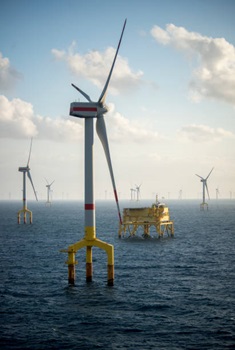


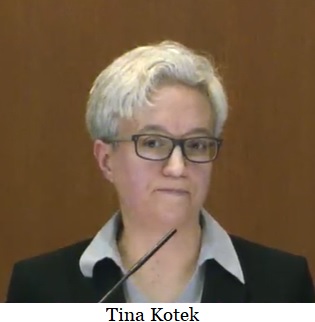

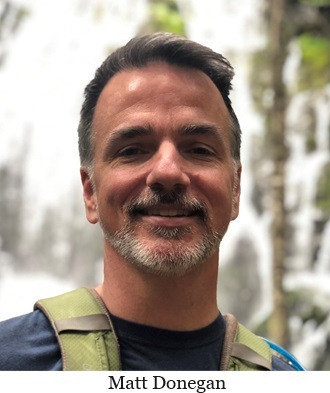


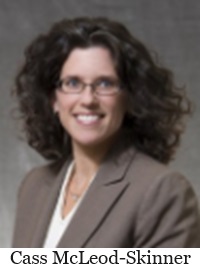
 “Political violence has no place in American politics. Certainly, those who believe that it does should not be in positions of authority in Oregon state government. With her amplification of pro-assassination messages, Cass McLeod-Skinner has demonstrated that she is unfit for the position she holds with the Oregon Board of Chiropractic Examiners. Gov. Kotek rightly denounced violence in the aftermath of the shooting, and now she has an opportunity to put her words into action by removing McLeod-Skinner from her position to signal that such dangerous rhetoric is unacceptable.”
“Political violence has no place in American politics. Certainly, those who believe that it does should not be in positions of authority in Oregon state government. With her amplification of pro-assassination messages, Cass McLeod-Skinner has demonstrated that she is unfit for the position she holds with the Oregon Board of Chiropractic Examiners. Gov. Kotek rightly denounced violence in the aftermath of the shooting, and now she has an opportunity to put her words into action by removing McLeod-Skinner from her position to signal that such dangerous rhetoric is unacceptable.”









 The chart is also an indication that forcing U.S. Employers to hire based on a DEI agenda rather than the quality of work is eroding in moral decay. Economist Dr. Elliott says, “Of course we aren’t going to be in the top 10 with that theology. I call it a theology because this DEI mantra is a religion to them… We are celebrating being the opposite of God in this country and that isn’t good for the economy… Biden is dedollarizing America by his policies.”
The chart is also an indication that forcing U.S. Employers to hire based on a DEI agenda rather than the quality of work is eroding in moral decay. Economist Dr. Elliott says, “Of course we aren’t going to be in the top 10 with that theology. I call it a theology because this DEI mantra is a religion to them… We are celebrating being the opposite of God in this country and that isn’t good for the economy… Biden is dedollarizing America by his policies.”

